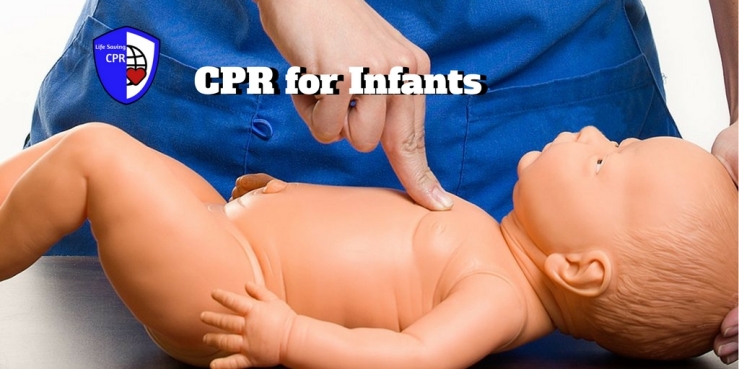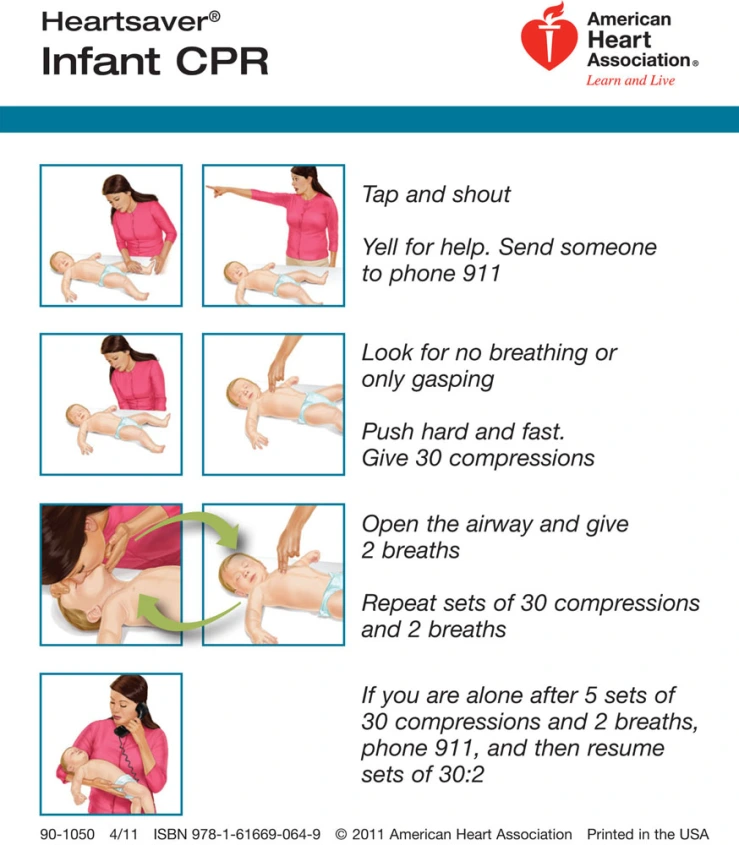CPR for Infants less than one year old include most of the same differences for CPR for Children. The basics of CPR are much the same for all ages, but there are differences based on common aliments requiring CPR pertaining to children and infants. Infants also have additional differences from children because of their size. We generally refer to the CPR differences for children and infants as Pediatric CPR; today we will focus on infants.

Our first step in CPR for Infants, as with CPR for anyone, is to asses the patient. We look for responsiveness and breathing, and determine the approximate age of the patient so that we can perform CPR the in the most effective way. For adults and children we would shout and shake the person to check for response. For infants we do not recommend shaking, it can cause shaken baby syndrome. Instead we recommend tapping the foot to check response on infants.
With assessment complete, our next step in CPR for Infants is to activate emergency response. This is where we find a difference between CPR for adults and CPR for infants and children. In a situation were you have no phone to call 911 and no one around to send to call for help you will have a decision. Adults are more likely having a cardiac issue. With no way to send or call for 911, you must leave the patient and get 911 yourself and then return to perform CPR. For both children and infants it is more likely a respiratory issue. With no one to send or no way to call it will depend on if you witnessed the collapse or not. If you witnessed the infant become unresponsive you know they have just had air moments before. In this case leave the infant to call 911 and return to do CPR as if it were an adult. If you did not witness the collapse you would not know how long the infant has been without air and you should perform CPR immediately. After performing CPR for about 2 minutes, if you still have no way to send or call for 911 you would then leave to activate emergency response. It should be noted that if you have a phone to call 911 or someone to send to call, then there is no difference and you call and perform CPR immediately for all ages.

Now that we have called for 911 its time to actually perform CPR for Infants. This is were the largest differences exist. Instead of a whole hand to compress the chest we would only need two fingers for infants. We use the nipple line as a guide for placement. Compress to the depth of 1/3rd the depth of chest. For adult and children the average 1/3rd depth is 2 inches, for infants the average 1/3rd depth is 1.5 inches. When giving breaths you will not need to give a lot of air, give just enough to see the chest rise, it will be much less air than for adults and children. One final important difference for infants is about opening the airway to give breaths. Tilt the head back just enough so that it looks like the infant is sniffing the air, the sniff position. If we overextend the the head too far back we can close the airway and cause additional injury.
Apart from those differences detailed here the rest of CPR for Infants has the same recommendations as CPR for all ages. Compress at the rate of 100 to 120 beats per minute. Follow the AED prompts as normal, but do use pediatric pads if available. Same ratio of compressions to breaths 30:2. If you are a healthcare professional there are a few additional differences and techniques for two rescuer on infants in Basic Life Support (BLS).
When you are ready to practice CPR for Infants in person, come to Life Saving CPR Training in Sacramento California for your American Heart Association (AHA) CPR course. Go to our website: https://cprskillssacramento.com/ to find the class schedule and to sign up for a class online. Or call (916) 672-2008 with questions or to sign up for a class over the phone. #CPRsavesLives even the small ones! #LifeisWhy!

[…] older adults are more likely to have cardiac events that will require CPR. This is not to say that Infants or Children don’t have CPR emergencies, they are just less […]
LikeLike
[…] are the same. Both courses cover the basics listed above for CPR for Adults, CPR for Children, and CPR for Infants. Both classes cover Choking emergencies and both classes cover the new topic of Opioid Overdose […]
LikeLike
[…] different examples. All of these courses cover the slight differences for Adult, Children, and Infant CPR. Make sure to consult your requirements and discuss the class options with the instructor to make […]
LikeLike
[…] All of our American Heart Association (AHA) CPR courses cover CPR for Adults, CPR for Children, and CPR for Infants. All courses also cover the Use of the AED and Choking Techniques. Beyond those shared topics, […]
LikeLike
[…] job requirement. This course, like all AHA CPR course, covers CPR for Adults, CPR for Children, and CPR for Infants. It covers both Hands Only CPR and CPR including Rescue Breaths, How to Use an AED, and […]
LikeLike
[…] for laypeople. The CPR material covered is also much the same. CPR basics for Adults, Children, Infants, and the Use of the AED utilize the same skills and are based on the same standards. Course prices […]
LikeLike